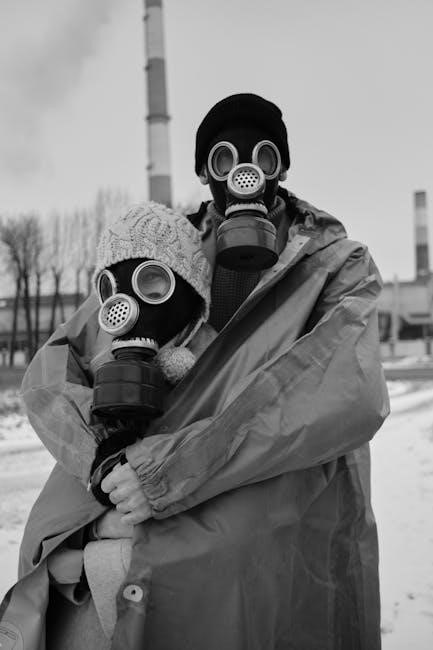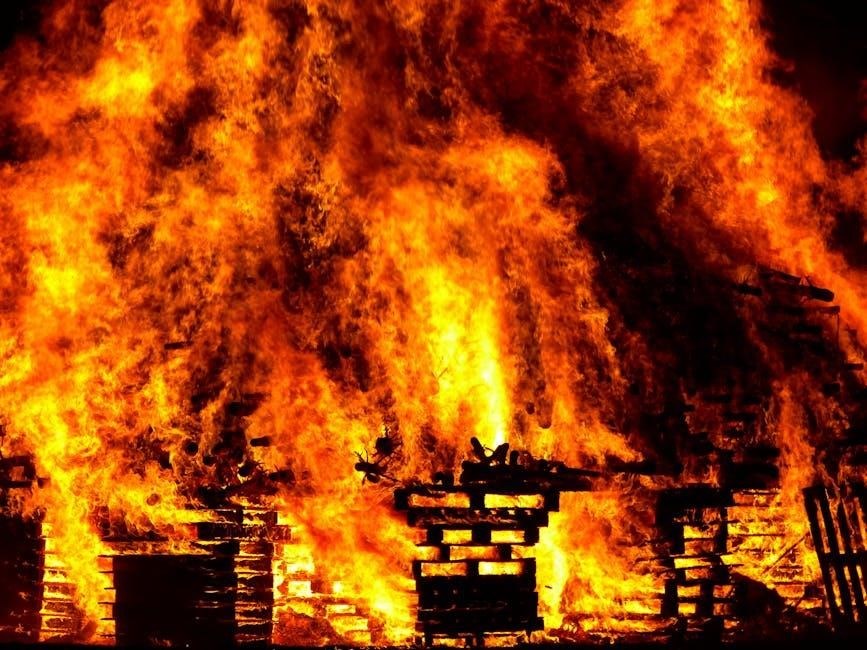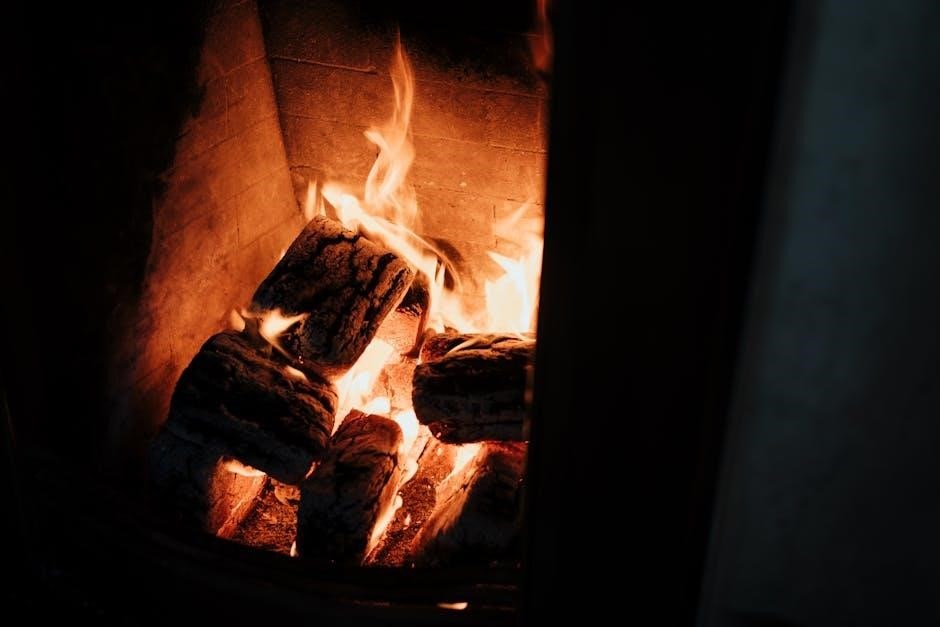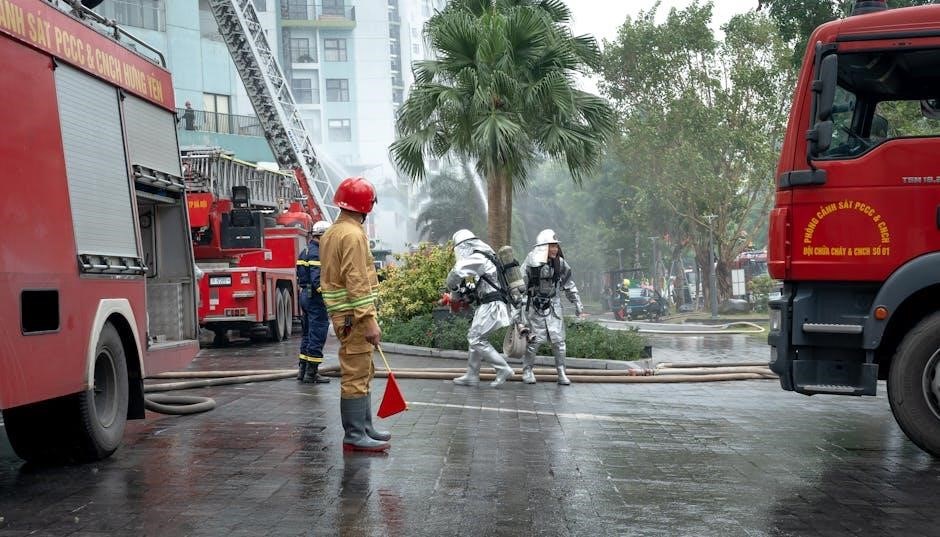First Alert Smoke & Carbon Monoxide Alarms are essential safety devices designed to protect homes from fire and CO hazards. They meet OSHA requirements and feature advanced technologies like dual-sensor detection and battery backup. These alarms provide early warnings, ensuring safety and peace of mind. Refer to the user manual for installation, maintenance, and troubleshooting guidance. Additional resources, including YouTube tutorials, are available for comprehensive support.
1.1 Overview of the First Alert SC7010BV Model
The First Alert SC7010BV is a dual-sensor smoke and carbon monoxide alarm designed for enhanced safety. It features a 120V plug-in design with battery backup, ensuring continuous protection during power outages. The device includes intelligent sensing technology to reduce false alarms and an LED indicator for status notifications. A locking mechanism prevents tampering, making it ideal for commercial settings. The SC7010BV meets OSHA requirements for CO alarms and is UL certified, ensuring compliance with safety standards. Its user manual provides detailed installation, maintenance, and troubleshooting instructions. Additional support is available through YouTube tutorials and customer service resources, making it a reliable choice for home and workplace safety.
1.2 Importance of Smoke and Carbon Monoxide Detectors
Smoke and carbon monoxide detectors are critical for early detection of potential threats, providing life-saving alerts during fires or CO leaks. Smoke detectors identify fire particles in the air, sounding alarms to prevent injury or property damage. Carbon monoxide detectors are equally vital, as CO is odorless, colorless, and deadly. Together, they offer comprehensive protection against two major household hazards. Early detection is key to preventing tragedies, making these devices indispensable for home and workplace safety. Their importance is underscored by safety regulations and recommendations from authorities like OSHA, ensuring they meet strict standards for reliability and effectiveness.
1.3 Key Benefits of Using First Alert Alarms
First Alert alarms offer exceptional reliability and advanced safety features, ensuring optimal protection for homes and families. Their dual-sensor technology provides accurate detection of both smoke and carbon monoxide, while intelligent sensing reduces false alarms. These alarms are easy to install and maintain, with battery backup ensuring continuous operation during power outages. Compliance with UL standards and OSHA requirements guarantees reliability and trustworthiness. Additionally, First Alert alarms are designed with user-friendly interfaces, including LED indicators for status updates. Their reputation for durability and effectiveness makes them a top choice for household safety, providing peace of mind for users.

Key Features of the First Alert Smoke & Carbon Monoxide Alarm
Dual-sensor technology, plug-in design with battery backup, intelligent sensing, LED indicators, and tamper resistance ensure reliable detection and user-friendly operation for enhanced home safety.
2.1 Dual-Sensor Technology for Smoke and CO Detection
The First Alert Smoke & Carbon Monoxide Alarm utilizes dual-sensor technology, combining optical and electrochemical sensors for accurate detection of smoke and carbon monoxide. This advanced system ensures rapid response to both types of threats, providing comprehensive protection for your home. The optical sensor detects smoke particles, while the electrochemical sensor identifies CO levels, offering enhanced accuracy and reliability. This dual-sensor design minimizes false alarms and maximizes sensitivity, ensuring your safety in various scenarios. By integrating both detection methods, the alarm delivers superior performance and peace of mind for homeowners.
2.2 120V Plug-In Design with Battery Backup
The First Alert Smoke & Carbon Monoxide Alarm features a 120V plug-in design, ensuring a reliable power source while allowing easy installation. A battery backup provides continuous protection during power outages, maintaining functionality even when the main power supply is interrupted. This dual-power system enhances safety by eliminating downtime, ensuring the alarm remains operational at all times. The plug-in design simplifies installation, while the battery backup offers peace of mind. This combination ensures uninterrupted monitoring for smoke and CO levels, providing comprehensive protection for your home and family.
2.3 Intelligent Sensing Technology for Reduced False Alarms
The First Alert Smoke & Carbon Monoxide Alarm incorporates intelligent sensing technology designed to minimize false alarms while maintaining high sensitivity. This advanced system distinguishes between real threats and everyday particles, such as cooking smoke or steam, reducing unnecessary alerts. By analyzing patterns and concentrations, the sensor accurately detects dangerous levels of smoke and CO without overreacting to harmless conditions. This technology enhances reliability, providing peace of mind while ensuring the alarm only sounds when a genuine hazard is present. It strikes a balance between safety and convenience, making it ideal for homes and commercial spaces.
2.4 LED Indicators for Status and Error Notifications
The First Alert Smoke & Carbon Monoxide Alarm features LED indicators that provide clear visual notifications for system status and potential issues. A green LED indicates normal operation, while a red LED flashes during an alarm event. An amber LED signals errors, such as low battery or sensor malfunctions. These indicators help users quickly identify the alarm’s status without guessing. They also assist in troubleshooting by highlighting specific issues, ensuring prompt resolution. This feature enhances user experience by offering real-time feedback, making it easier to maintain the alarm’s functionality and ensure continuous protection. LED notifications are a reliable way to stay informed about the alarm’s condition.
2.5 Locking Mechanism to Prevent Tampering
The First Alert Smoke & Carbon Monoxide Alarm includes a locking mechanism designed to prevent unauthorized tampering or removal. This feature is especially useful in rental properties, commercial spaces, or homes with children. The locking bracket secures the alarm to the wall or ceiling, requiring a tool to remove or adjust the unit. This ensures that the alarm remains operational and cannot be disabled or relocated without permission. The locking mechanism adds an extra layer of security, maintaining the safety of the premises and ensuring continuous protection against smoke and carbon monoxide threats. This feature is essential for maintaining compliance in regulated environments. It guarantees reliability and prevents accidental or intentional disarming of the device. The locking mechanism is a practical solution to prevent tampering, ensuring the alarm remains functional and ready to alert occupants in case of danger. By securing the alarm, it provides peace of mind and enhances overall safety. This feature is particularly beneficial in situations where the alarm’s integrity must be maintained, such as in public spaces or shared living areas. The locking mechanism is a testament to the alarm’s robust design and commitment to user safety. It ensures that the device remains a reliable guardian against potential hazards, offering uninterrupted protection for everyone. The inclusion of this feature underscores the importance of maintaining a secure and tamper-proof safety system in any setting. By preventing unauthorized access, the locking mechanism plays a crucial role in ensuring the alarm’s effectiveness and longevity. It is a thoughtful addition that addresses potential vulnerabilities, making the First Alert Smoke & Carbon Monoxide Alarm a dependable choice for safety-conscious individuals and organizations. The locking mechanism not only enhances security but also aligns with safety regulations, ensuring that the alarm meets rigorous standards for reliability and performance. This feature is a key aspect of the alarm’s design, demonstrating a comprehensive approach to safety and user needs. By incorporating a locking mechanism, First Alert has created a product that is both secure and user-friendly, catering to a wide range of environments and applications. The locking mechanism is a vital component that ensures the alarm remains operational and effective, providing consistent protection against smoke and carbon monoxide threats. It is a testament to the brand’s commitment to innovation and safety, offering users a reliable and tamper-proof solution for their safety needs. The locking mechanism is an essential feature that enhances the overall functionality and reliability of the First Alert Smoke & Carbon Monoxide Alarm, making it a top choice for those seeking a secure and efficient safety system. By preventing tampering, it ensures that the alarm remains a trusted guardian, always ready to alert occupants in case of danger. This feature is a reflection of the brand’s dedication to providing high-quality, user-centric products that meet the demands of modern safety requirements. The locking mechanism is a practical and effective solution to prevent unauthorized changes, ensuring the alarm’s optimal performance and reliability. It is a key element in maintaining the integrity of the safety system, offering users peace of mind and confidence in their protection. The locking mechanism is a well-designed feature that addresses potential vulnerabilities, ensuring that the First Alert Smoke & Carbon Monoxide Alarm remains a steadfast protector against hidden dangers. By securing the alarm, it provides a consistent and reliable safety solution, aligned with the highest standards of quality and performance. The locking mechanism is a valuable addition to the alarm’s design, reinforcing its position as a leader in home and commercial safety devices. It is a feature that resonates with users who prioritize security and reliability, offering them a robust solution to safeguard their properties and loved ones. The locking mechanism is a clear example of how First Alert continues to innovate and adapt to the evolving needs of safety-conscious consumers, ensuring that their products remain at the forefront of the industry. By incorporating this feature, the brand has created a product that not only meets but exceeds expectations, providing users with a tamper-proof and dependable safety system. The locking mechanism is a vital component that ensures the First Alert Smoke & Carbon Monoxide Alarm remains a trusted and effective safety solution for years to come. It is a feature that underscores the brand’s commitment to excellence and user satisfaction, offering a secure and reliable way to protect against smoke and carbon monoxide hazards. The locking mechanism is a well-thought-out addition that enhances the overall value of the alarm, making it a preferred choice for those seeking a high-quality safety device. By preventing tampering, it ensures that the alarm remains fully functional and ready to respond to potential threats, providing users with the peace of mind they deserve. The locking mechanism is a testament to the brand’s dedication to safety and innovation, offering a secure and efficient solution for modern safety needs. It is a feature that sets the First Alert Smoke & Carbon Monoxide Alarm apart from competitors, solidifying its reputation as a reliable and user-friendly safety device. The locking mechanism is a practical and effective solution that addresses the need for a tamper-proof safety system, ensuring that the alarm remains operational and effective in various environments. By securing the alarm, it provides a consistent and reliable safety solution, meeting the demands of both residential and commercial settings. The locking mechanism is a key feature that enhances the overall performance and reliability of the First Alert Smoke & Carbon Monoxide Alarm, making it a top choice for safety-conscious individuals and organizations. It is a feature that demonstrates the brand’s commitment to providing high-quality, secure, and efficient safety solutions, ensuring that users can rely on the alarm to protect their properties and loved ones. The locking mechanism is a well-designed feature that prevents unauthorized tampering, ensuring that the alarm remains fully functional and ready to respond to potential threats. It is a vital component that underscores the brand’s focus on safety and user satisfaction, offering a secure and reliable safety system. The locking mechanism is a valuable addition to the alarm’s design, providing users with peace of mind and confidence in their safety. It is a feature that aligns with modern safety standards, ensuring that the First Alert Smoke & Carbon Monoxide Alarm remains a trusted and effective safety solution for years to come. The locking mechanism is a clear example of how First Alert continues to prioritize user needs and safety, offering a robust and tamper-proof device that meets the demands of various environments. By securing the alarm, it ensures continuous protection against smoke and carbon monoxide hazards, providing users with a reliable and efficient safety system. The locking mechanism is a testament to the brand’s commitment to innovation and excellence, offering a secure and user-friendly solution for safety-conscious consumers. It is a feature that enhances the overall value of the alarm, making it a preferred choice for those seeking a high-quality safety device. The locking mechanism is a well-thought-out addition that addresses the need for a tamper-proof safety system, ensuring that the First Alert Smoke & Carbon Monoxide Alarm remains a steadfast protector against hidden dangers. By preventing unauthorized changes, it ensures that the alarm remains fully functional and ready to alert occupants in case of an emergency. The locking mechanism is a key feature that enhances the overall functionality and reliability of the alarm, making it a top choice for both residential and commercial use. It is a feature that resonates with users who prioritize security and reliability, offering them a robust solution to safeguard their properties and loved ones. The locking mechanism is a clear example of how First Alert continues to innovate and adapt to the evolving needs of safety-conscious consumers, ensuring that their products remain at the forefront of the industry. By incorporating this feature, the brand has created a product that not only meets but exceeds expectations, providing users with a tamper-proof and dependable safety system. The locking mechanism is a vital component that ensures the First Alert Smoke & Carbon Monoxide Alarm remains a trusted and effective safety solution for years to come. It is a feature that underscores the brand’s commitment to excellence and user satisfaction, offering a secure and reliable way to protect against smoke and carbon monoxide hazards. The locking mechanism is a well-designed feature that prevents unauthorized tampering, ensuring that the alarm remains fully functional and ready to respond to potential threats. It is a testament to the brand’s dedication to safety and innovation, offering a secure and efficient solution for modern safety needs. The locking mechanism is a practical and effective solution that addresses the need for a tamper-proof safety system, ensuring that the alarm remains operational and effective in various environments. By securing the alarm, it provides a consistent and reliable safety solution,

Installation Instructions
Follow step-by-step guide for proper installation, ensuring correct mounting, wiring, and battery insertion. Test the alarm after installation to ensure functionality.
3.1 Step-by-Step Guide to Installing the Alarm
Begin by selecting a suitable location for the alarm, ensuring compliance with safety standards. Carefully unpack the device and its components. Use the provided mounting bracket to secure the unit to the wall or ceiling. Attach the alarm to the bracket firmly. Insert the backup battery, ensuring proper orientation. Plug the alarm into a 120V outlet for primary power. Test the device by pressing the test button to verify functionality. Ensure all connections are secure and the alarm is level. Refer to the manual for specific wiring instructions if hardwiring. Finally, test the alarm again to confirm proper operation.
3.2 Choosing the Optimal Location for Installation
For maximum effectiveness, install the First Alert Smoke & Carbon Monoxide Alarm on every level of your home, including inside each bedroom and outside sleeping areas. Position the alarm at least 10 feet away from cooking appliances to minimize false alarms. Avoid installing near windows, doors, or bathrooms, as drafts or moisture may interfere with performance. Mount the alarm on walls or ceilings, ensuring it is at least 4 inches away from corners to avoid dead air spaces. This placement ensures comprehensive coverage and reliable detection of both smoke and carbon monoxide.
3.3 Tools and Materials Required for Installation
To install the First Alert Smoke & Carbon Monoxide Alarm, you will need a few essential tools and materials. Begin with a drill and appropriate drill bits for making pilot holes. A screwdriver, either flathead or Phillips, is necessary for securing the mounting bracket. Wall anchors or screws are required for attaching the bracket to the wall or ceiling. Additionally, a ladder or step stool may be needed to reach high installation areas. Ensure all power sources are turned off before starting. Having a vacuum cleaner handy to clean the area can also improve installation efficiency and ensure proper sensor function.

Recommended Placement for Maximum Effectiveness
Place alarms on every level of your home and inside each bedroom. Install near the ceiling, away from windows and doors, to ensure optimal detection of smoke and CO.
4.1 Placement in Bedrooms and Living Areas
Install smoke and carbon monoxide alarms in every bedroom and outside each sleeping area. Place them on the ceiling or wall, at least 10 feet away from cooking appliances. In bedrooms, position alarms near the door to ensure early detection. For living areas, install alarms in central locations to cover the entire space. Avoid placing near windows, doors, or ducts to minimize false alarms. Ensure alarms are interconnected so they sound simultaneously, providing maximum protection. This placement strategy ensures early warning in case of emergencies, helping occupants evacuate safely and quickly.
4.2 Strategic Locations to Ensure Full Coverage
For comprehensive protection, place alarms in hallways outside bedrooms and in main staircases to ensure smoke and CO detection throughout the home. Install units near heating systems, like furnaces or water heaters, as these are common sources of carbon monoxide. Position alarms at least 10 feet away from cooking appliances to minimize false alarms. Avoid areas with direct sunlight, high humidity, or extreme temperatures. By strategically locating alarms in these key areas, you ensure full coverage and early detection, enhancing safety for all occupants. This placement ensures alarms can sound quickly in case of emergencies.
4.3 Avoiding Areas Prone to False Alarms
Avoid installing alarms in areas prone to false alarms, such as near kitchens, bathrooms, or laundry rooms, where steam or cooking fumes can trigger unwanted alerts. Do not place alarms near fireplaces, wood-burning stoves, or areas with direct sunlight, as these can cause sensor interference. Additionally, avoid installing alarms in garages or near windows where outdoor fumes may enter. Keep alarms at least 10 feet away from fuel-burning appliances. By avoiding these areas, you reduce the likelihood of false alarms, ensuring the device operates reliably and provides accurate detections when needed.

Maintenance and Troubleshooting
Regularly clean the alarm to ensure optimal performance. Check sensors and power sources. Troubleshoot issues like false alarms or low battery warnings for reliable operation.
5.1 Regular Cleaning and Dust Removal
Regular cleaning is essential to maintain the performance of your First Alert smoke and carbon monoxide alarm. Use a vacuum cleaner with a soft brush attachment to gently remove dust and debris from the exterior and vents. Avoid using chemicals, water, or abrasive materials, as they may damage the unit. Clean the alarm monthly or more frequently in dusty environments. After cleaning, test the alarm to ensure it functions properly. This simple maintenance step helps prevent false alarms and ensures accurate detection of smoke and CO levels. Regular dust removal is crucial for the longevity and reliability of your safety device.
5.2 Replacing Batteries and Checking Power Sources
To ensure uninterrupted protection, replace the backup batteries annually or when the low-battery chirp sounds. Use high-quality AA alkaline batteries for optimal performance. Open the battery compartment, located on the back of the unit, and replace the old batteries with new ones. Ensure the batteries are installed correctly to maintain proper function. Additionally, check the 120V power source by verifying that the plug is securely connected to a working outlet. If the alarm is hardwired, inspect the wiring for any damage or loose connections. Regularly inspecting the power sources ensures your alarm remains operational and ready to detect threats. Always test the unit after replacing batteries or checking power sources.
5.3 Silencing False Alarms and Resetting the Unit
To silence a false alarm, press and hold the test/silent button until the alarm stops. This feature temporarily mutes the unit. If the alarm persists, check for potential causes like cooking smoke or steam. After addressing the issue, the unit will automatically reset. For a manual reset, unplug the alarm, remove the battery, and press the test button for 10 seconds. Reinstall the battery or plug it back in. The alarm will chirp once to indicate it’s resetting. Ensure the environment is clear of smoke or CO before resetting to avoid recurring false alarms. Always test the unit after silencing or resetting to confirm proper function.
5.4 Troubleshooting Common Issues
Common issues with the First Alert smoke and carbon monoxide alarm include chirping noises, false alarms, or connectivity problems. For chirping, check the battery or power source and replace if necessary. If connected to an AC power supply, ensure it is functioning properly. For false alarms, clean the unit with a vacuum or soft brush to remove dust. If the alarm is interconnected, ensure all units are synced correctly. If issues persist, reset the unit by unplugging, removing the battery, and pressing the test button for 10 seconds. Contact customer support if problems remain unresolved.

Understanding the Different Models Available
First Alert offers various smoke and carbon monoxide alarm models, each with unique features to suit different needs, ensuring comprehensive safety solutions for any home or workspace.
6.1 First Alert SC7010BV vs. Other Models
The First Alert SC7010BV stands out among other models due to its advanced dual-sensor technology, which enhances detection accuracy for both smoke and carbon monoxide. Unlike some models, it features a 120V plug-in design with battery backup, ensuring continuous protection during power outages. The SC7010BV also includes intelligent sensing technology to reduce false alarms, a feature not found in all First Alert alarms. Additionally, its voice alarm with location identifier and wireless interconnectivity options make it more versatile than earlier models. This combination of features makes the SC7010BV a top choice for comprehensive home safety, meeting UL certification standards and offering a 10-year sensor lifespan.
6.2 Specialized Features in Different Models
First Alert offers a range of smoke and carbon monoxide alarms, each with unique features tailored to specific needs. Some models include Wi-Fi connectivity for smartphone alerts, while others have 10-year sealed battery options for hassle-free maintenance. Certain alarms feature voice notifications, providing location-specific alerts during emergencies. Additionally, select models are equipped with smart sensors that adjust sensitivity based on environmental conditions, reducing false alarms. These specialized features allow users to choose the alarm that best fits their lifestyle and home requirements, ensuring enhanced safety and convenience.
6.3 Choosing the Right Model for Your Needs
Selecting the appropriate First Alert smoke and carbon monoxide alarm model involves assessing your specific needs. Consider the size of your space, the number of levels in your home, and the types of hazards you want to detect. If you prioritize smart home integration, look for models with Wi-Fi connectivity. For homes with children, voice alerts can enhance safety. Budget is also a key factor, as models vary in price based on features. By evaluating these factors, you can choose a model that balances functionality, cost, and reliability, ensuring optimal protection for your home and family.

Compliance with Safety Standards
First Alert smoke and carbon monoxide alarms meet rigorous UL certification and OSHA requirements, ensuring reliability and safety in both residential and commercial settings.
7.1 Meeting OSHA Requirements for CO Alarms

First Alert smoke and carbon monoxide alarms are designed to meet OSHA standards, ensuring workplaces are protected from hazardous CO levels. These alarms detect CO concentrations as low as 50 ppm, aligning with OSHA’s permissible exposure limits. The alarms feature audible alerts exceeding 85 decibels, ensuring clear notification in noisy environments. Additionally, they include visual indicators for comprehensive monitoring. Employers can rely on these devices to maintain compliance with OSHA regulations, safeguarding employees from CO poisoning risks. Regular testing and maintenance, as outlined in the manual, further ensure adherence to workplace safety standards.
7.2 UL Certification and Other Safety Standards
First Alert smoke and carbon monoxide alarms are UL (Underwriters Laboratories) certified, ensuring they meet rigorous safety standards for detection accuracy and reliability. These alarms comply with UL 2034 for carbon monoxide detectors and UL 217 for smoke detectors, guaranteeing comprehensive protection. Additionally, they adhere to NFPA (National Fire Protection Association) guidelines and ICD-10 codes for CO poisoning prevention. This dual certification ensures the devices function optimally in various conditions, providing enhanced safety and peace of mind for users. Compliance with these standards confirms the alarms’ ability to detect threats accurately and alert occupants reliably.
7.3 Ensuring Compliance in Commercial Settings
First Alert smoke and carbon monoxide alarms are designed to meet strict safety regulations in commercial environments. They comply with local fire codes, NFPA standards, and IBC requirements, ensuring legal and operational compliance. Regular inspections and maintenance are crucial to uphold certification. Commercial settings must install alarms in accordance with manufacturer guidelines and local ordinances. Failure to comply may result in penalties or compromised safety. Proper placement, testing, and record-keeping are essential to ensure continuous protection and adherence to regulatory standards, making First Alert alarms a reliable choice for commercial safety needs.

User Manual Overview
The user manual provides detailed instructions, key features, installation steps, maintenance tips, and troubleshooting guides for the First Alert smoke and carbon monoxide alarm.
8.1 Navigating the Manual for Key Information
The First Alert smoke and carbon monoxide alarm manual is designed for easy navigation, ensuring users can quickly find essential information. The manual is divided into clear sections, such as installation, maintenance, and troubleshooting, making it simple to locate specific guidance. Key features like sensor types, battery replacement, and error codes are highlighted for quick reference. Users can also find detailed diagrams and step-by-step instructions to understand and operate the alarm effectively. The manual emphasizes safety precautions and provides tips for optimal performance, ensuring homeowners can confidently manage their smoke and carbon monoxide detection system.
8.2 Important Safety Precautions
Always follow the safety precautions outlined in the First Alert smoke and carbon monoxide alarm manual to ensure proper function and user safety. Never disable or tamper with the alarm, as this can lead to life-threatening situations. Avoid placing the alarm near cooking areas or bathrooms, as steam or fumes may trigger false alarms. Do not use the alarm near open flames or sparks. Ensure the unit is installed at least 10 feet away from fuel-burning appliances. Never use the wrong battery type, as this can cause malfunction. Keep the alarm out of reach of children and pets to prevent accidental damage. Always test the alarm monthly and replace it every 10 years, as specified. Failure to follow these precautions may result in reduced performance or safety risks. Regularly check for dust or debris buildup, as this can impair sensor accuracy. If the alarm sounds and no danger is present, identify and resolve the cause before silencing it. Never ignore persistent alarms, as they may indicate a genuine threat. Always prioritize safety by adhering to the manufacturer’s guidelines to protect yourself and your household from potential hazards. By following these precautions, you can ensure the alarm operates effectively and provides reliable protection. Proper maintenance and adherence to safety protocols are crucial for maximizing the device’s performance and longevity. Keep the manual handy for quick reference and updates on safety measures. Familiarize yourself with local safety regulations and ensure compliance. Remember, the alarm is a critical safety device, and its proper use is essential for preventing tragedies. Stay informed and proactive to maintain a safe environment. Correct usage and maintenance are vital to ensure the alarm functions as intended. Always store the manual in an accessible location for future reference. Ensure all household members understand the alarm’s operation and safety guidelines. This collective awareness enhances overall safety and preparedness. By taking these precautions seriously, you can trust the alarm to provide accurate warnings and protect your home and family from potential dangers. Regular reviews of the manual and adherence to its instructions are key to maintaining a safe and secure living environment. Always prioritize safety when handling and maintaining the alarm to avoid any risks. The manual serves as a comprehensive guide, so use it to stay informed and ensure the alarm’s reliability. Proper care and attention to safety details will help prevent accidents and ensure the alarm’s effectiveness in emergency situations. Stay vigilant and proactive in maintaining a safe home environment by following the manual’s guidelines. The safety of your household depends on it.

Additional Resources and Support
8.3 Warranty and Support Information
The First Alert smoke and carbon monoxide alarm is backed by a limited warranty, typically covering defects in materials and workmanship for a specified period, often 5 to 10 years. To activate the warranty, register your product on the First Alert website or via mail. For assistance, contact First Alert’s customer service at 1-800-323-9005 or visit their official website. The manual also provides details on how to file a warranty claim and access support resources. Keep your proof of purchase handy, as it may be required for warranty services. For additional help, refer to the FAQs or downloadable guides on their website. Always ensure compliance with the manual’s instructions to maintain warranty validity. If issues arise, contact support promptly for troubleshooting or replacement. The warranty ensures peace of mind, knowing your safety device is protected. Visit firstalert.com/support for more information or to reach their team. Proper registration and adherence to warranty terms ensure uninterrupted protection for your home. Never hesitate to seek help if your alarm malfunctions, as timely resolution is crucial for safety. The warranty and support services are designed to keep your alarm functioning optimally, safeguarding your household from potential threats. Always rely on First Alert’s dedicated support team for any concerns or issues. Your safety is their priority, and the warranty ensures your alarm remains reliable and effective. For a seamless experience, explore their online resources or contact their friendly representatives. Remember, your warranty is your assurance of quality and reliability from First Alert.